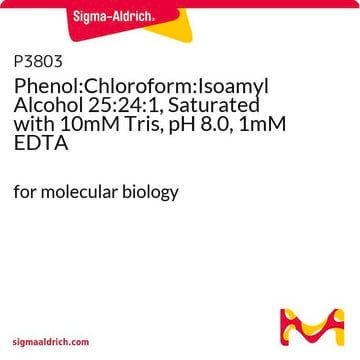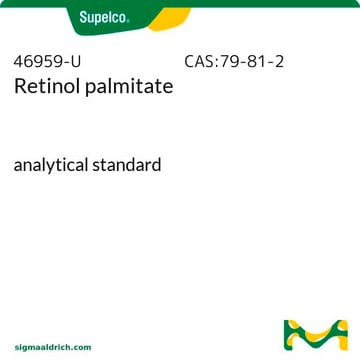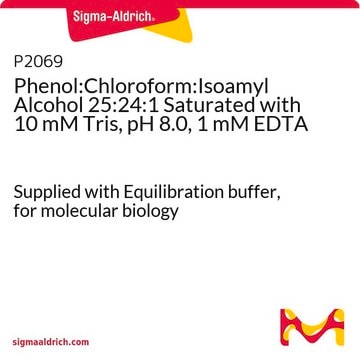The melting point of Retinyl palmitate is very close to room temperature, about 25-30°C. However, melting point is not part of the Quality Control (QC) specifications for any of the Retinyl palmitate products listed.
The differences in purity testing for each is as follows:
Product R1512 is assayed for potency in USP units per gram, but not purity. The minimum activity is 1.7M units per gram.
Product R3375 is assayed for both potency in USP units per gram and purity by HPLC. The average activity is 1.8M units per gram. The minimum purity is 90%.
Product PHR1235 is a Certified Reference Material (CRM) that is traceable to the USP primary standard and assayed for both potency in USP units per gram and purity by HPLC. Values are reported on a lot specific basis as compared to the current USP primary standard 1602502.
R1512
Retinyl palmitate
potency: ≥1,700,000 USP units per g
Synonym(s):
Vitamin A palmitate, all−trans−Retinol palmitate
Select a Size
About This Item
Recommended Products
biological source
synthetic (organic)
form
solid or viscous liquid
potency
≥1,700,000 USP units per g
does not contain
antioxidant
color
yellow to yellow-green
mp
26 °C
storage temp.
2-8°C
SMILES string
CC1=C(/C=C/C(C)=C/C=C/C(C)=C/COC(CCCCCCCCCCCCCCC)=O)C(C)(C)CCC1
InChI
1S/C36H60O2/c1-7-8-9-10-11-12-13-14-15-16-17-18-19-25-35(37)38-30-28-32(3)23-20-22-31(2)26-27-34-33(4)24-21-29-36(34,5)6/h20,22-23,26-28H,7-19,21,24-25,29-30H2,1-6H3/b23-20+,27-26+,31-22+,32-28+
InChI key
VYGQUTWHTHXGQB-FFHKNEKCSA-N
Looking for similar products? Visit Product Comparison Guide
General description
Application
Biochem/physiol Actions
Packaging
Physical form
signalword
Danger
hcodes
Hazard Classifications
Aquatic Chronic 3 - Repr. 1B
Storage Class
6.1C - Combustible acute toxic Cat.3 / toxic compounds or compounds which causing chronic effects
wgk_germany
WGK 2
flash_point_f
No data available
flash_point_c
No data available
ppe
Eyeshields, Gloves, type ABEK (EN14387) respirator filter
Choose from one of the most recent versions:
Already Own This Product?
Find documentation for the products that you have recently purchased in the Document Library.
Customers Also Viewed
-
What is the difference in purity and melting point among Retinyl palmitate PHR1235, R3375 and R1512?
1 answer-
Helpful?
-
Active Filters
Our team of scientists has experience in all areas of research including Life Science, Material Science, Chemical Synthesis, Chromatography, Analytical and many others.
Contact Technical Service











